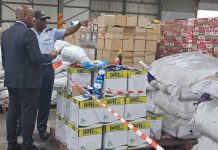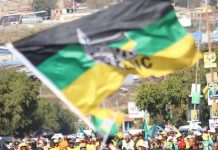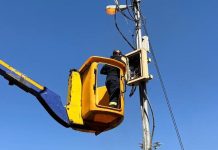Africa-Press – South-Africa. At the heart of the North West province, roughly an hour’s drive from Mahikeng, lies one of the country’s worst-run municipalities.
Ditsobotla provides the perfect illustration of what happens when municipalities are allowed to run amok with little to no oversight from provincial or national executive structures.
Often interventions come far too late or are ineffective, as was the case with Ditsobotla, which has been under some form of administration or directive on at least seven occasions since 2008.
By the time the decision to dissolve the municipality came in October 2022, the local government was in a state of total collapse.
In towns where refuse piles up, sewage covers streets and taps run dry, it is the residents and communities that pay the ultimate price for this lack of oversight.
The problems within the Ditsobotla municipality didn’t happen overnight, but are the end result of a steady breakdown in basic services over the past decade. Without proper maintenance coupled with the lack of oversight, the municipality deteriorated to a state of complete crisis.
“This place is broken,” says a source from within the municipality, who requested they remain anonymous because they had been receiving death threats. “There is nothing left to break in Ditsobotla. You don’t break a place in a year or even three years, this has been a long time coming and it’s basically a ripple effect from council to council.”
A portrait of dysfunction
Underscoring the general decay of the municipality was a rotten core sustained through political instability and infighting – all of which went largely unchecked until it had spiralled out of control.
Carin Visser, a member of the National Council of Provinces select committee on Cooperative Governance and Traditional Affairs, Water and Sanitation and Human Settlements, explains:
She adds: “It starts becoming like a cancer growing and growing to such an extent that you start getting the implosion of services.”
Visser was part of the team that visited Ditsobotla in September 2022 to take a closer look at the issues within the municipality.
Although, Visser notes that this is not a problem unique to Ditsobotla: “I’ve visited all the municipalities in the North West, all over the same disease and condition is too prevalent in every single one of these municipalities.”
A total of 64 dysfunctional municipalities were identified across the country, in an August 2021 presentation to the Portfolio Committee on Cooperative Governance and Traditional Affairs (Cogta). This means one in four municipalities were dysfunctional. Additionally, 163 out of South Africa’s 257 municipalities were noted as being under financial distress.
Of the 64 dysfunctional municipalities, less than half had been placed under administration – with no word on why the remaining 36 had been left without a plan. At the time of the presentation, Ditsobotla had been identified as a dysfunctional municipality but was not under any form of intervention.
Over time, while its services were crumbling due to lack of maintenance, the municipality had also managed to rack up an extraordinary amount of debt to the extent that its debts – mainly to Eskom – exceeded its assets by nearly R1 billion by 2019.
In a 10-year period of audits from 2010/11 to 2020/21, Ditsobotla had a disclaimer on their report for nine years, meaning there wasn’t enough paperwork to verify the accuracy of the municipality’s finances.
Despite having already achieved its dysfunctional status, it took the emergence of duplicate rival councils and thugs taking control of the municipal offices to prompt the council’s dissolution in October 2022.
But when problems have existed for so long within a municipality, sometimes even starting from scratch may not be enough.
“Ditsobotla was in trouble for more than 10 years,” says Visser.
She adds:
Drips and drops: Ditsobotla’s ongoing water crisis
While it would be a hard task to find something that works within the municipality, perhaps one of the biggest issues has been the failure to provide water.
Even now, residents have a limited water supply, which according to the source, is split into three to four hours in the morning and then two to three hours of water in the evening.
The source says: “In essence, we have water for about six hours a day, at most. It boils down to non-maintenance, and no provision for jobs and projects that are in the pipeline that have never been implemented.”
Water supply to the area has been irregular for years. This is in part due to droughts limiting the amount of water available, but became acute due to mismanagement of water infrastructure.
Ditsobotla falls within the Ngaka Modiri Molema district municipality, which is in charge of ensuring that adequate water is being supplied to towns through boreholes or a reservoir.
It is then up to the local municipality, in this case Ditsobotla, to take charge of distributing the water from the source to households or taps.
A 2020 investigation by the Public Protector’s office found that the district municipality had “failed to ensure that water service equipment [was] regularly maintained and that old infrastructure was refurbished”.
The report also noted that the municipality “failed to prepare a Water Service Development Plan during the periods 2012 to 2019”, a requirement in the Water Services Act that should serve as a planning roadmap for a municipality to create a long-term sustainable water supply.
The Public Protector’s report cited nine overdue water supply projects in the local municipalities Ramotshere Moiloa, Ratlou, Ditsobotla and Mahikeng. These projects included: “the replacement of pumps, installation of electric cables, configuration of reticulation networks, augmentation of storage facilities, fixing nonfunctional boreholes, construction of reservoirs and pump housing”.
Despite two years having passed since the investigation results were released, areas continue to struggle with getting adequate water. In August 2022, residents in Lichtenburg experienced a six-week blackout where they had little to no water being provided and had become entirely reliant on private boreholes or alternative suppliers.
Following this, Sakeliga filed an urgent case at the Mahikeng High Court in October 2022 to address the litany of failures at the municipality.
Sakeliga (previously known as Afribusiness and historically affiliated with AfriForum) identifies itself as a non-profit business interest organisation.
The papers provide a window into the drama leading Sakeliga to seek “an urgent and effective interim remedy” in respect of what they termed “a serious constitutional crisis” in Ditsobotla.
Sakeliga’s Christo Bester noted: “At date of deposing to this affidavit: The offices of the municipality are locked and closed; municipal employees have not been fully paid and refuse to work due to non-payment… there is no individual (not to speak of any leadership) in control of the municipality… anarchy reigns… and the provision of the most basic municipal services has ground to a halt… The failure is also a serious public health, safety and environmental concern.”
Bester informed the court: “The towns of Lichtenburg and Coligny are receiving little to no water due to water not being pumped and reservoirs running dry. There are no municipal staff available to attend to breakdowns in the water and electricity reticulation networks. Many residents have been without water and/or electricity due to breakdowns in the network for weeks.”
He added:
He said residents had turned to “trucking in water from farms and other areas with private boreholes”.
Businesses were also affected, with OK Foods in Lichtenberg having to install its own water system that required refills up to four times a day. The store owner said that drivers made an 80km trip to collect water from nearby farms in order to ensure the supermarket could keep its doors open.
Those hit hardest by the shortages were informal settlements and other residential areas.
The systematic destruction of a municipality
Sakeliga’s court papers describe the situation in Ditsobotla as “a complete collapse of the municipality, with devastating consequences to the community”.
Aside from a lack of water, there was a breakdown of nearly all basic services to the area – and private suppliers were stepping up in the municipality’s place.
One such instance was refuse collection for the towns. When trash began piling up, some community members began trying to take care of it themselves, but didn’t have access to dump sites. Instead, the garbage started piling up at the site’s entrance, which made it more difficult to properly dispose of the waste.
It wasn’t merely trash clogging up streets, however, as blocked pipes led to wastewater flooding the streets and illegal dumping sites began popping up next to roads.
Residents in Coligny spend so much of their time trying to deal with sewage removal that they’ve created their own roster and have organised and paid for sucker trucks to help deal with major blocks in the pipes.
The problems are not limited to just one town, with raw sewage seeping into the Harts River (which flows into the Vaal River) and polluting the water that supplies neighbouring town Schweizer Reneke in the Kgetlengrivier municipality.
Municipal employees had also gone about three months (starting in August 2022) without receiving their salaries and the municipality offices had been locked up, leaving no one to deliver maintenance or services.
Some rogue employees then set about finding other ways to make money during this period. The court papers detail a choice “between clearing their own sewage or paying an additional ‘fee’ (bribe) to municipal employees”, with services not being provided unless residents provided private payments.
The court filing goes on to say: “Worse still, certain of such employees have organised themselves into vigilante units, apparently terminating the power of community members and businesses and thereafter demanding cash payments to reconnect such power. It is not an exaggeration to describe the situation in Lichtenburg and Coligny as anarchy.”
In replying papers filed after government had attempted to appoint an administrator, Bester note: “As the respondents have admitted, ‘gangsterism’ now reigns in Ditsobotla. It is this total collapse that renders the matter urgent.
“Insofar as the opposing respondents imply that the appointment of the administrator has lessened the urgency of the situation, I deny that this is correct… The administrator himself confirmed that on 11 October 2022 he was prevented from accessing the municipality’s premises by bouncers employed by the company that is rendering security services to the municipality… the administrator was not only prevented from accessing the municipal offices, but was physically assaulted together with his bodyguard who was stabbed in his head, and the office of the administrator was destroyed in violence.”
Ditsobotla has rejected its administrator on three separate occasions, refusing them access to the municipality, according to Dineo Thapelo, Cogta spokesperson for North West. Security was provided for the administrators and they worked remotely from the Mmbatho offices.
Sakeliga’s challenge
The case has exposed the inadequacy of government’s response, practically and legally.
Instead of addressing the core governance issues, government has put up weak legal points to try to divert the litigation, such as arguing the matter is not urgent – an approach batted away by the court.
In addition to practical steps, Sakeliga has asked the court to declare the national government’s failure to intervene, in terms of Section 139(7) of the Constitution, a constitutional violation. Such a ruling will put pressure on the national government to intervene in other municipalities.
Section 139 provides for various provincial interventions in local government, where a municipality is failing.
Section 139(5) provides that if a municipality is in serious or persistent material breach of its obligations to provide basic services or to meet its financial commitments, the relevant provincial executive must, depending on the severity of the situation, impose a recovery plan; or dissolve the Municipal Council and appoint an administrator; or assume responsibility for the implementation of the recovery plan to the extent that the municipality does not or cannot.
A Section 139(5) intervention was belatedly imposed on Ditsobotla on 21 November 2022 and it is still in the process of being implemented.
Section 139(7) provides that if a provincial executive cannot or does not or does not adequately exercise the powers referred to in Subsection 5, the national executive must intervene in the stead of the relevant provincial executive.
According to the state’s own papers, in May 2021, following a Gauteng High Court judgment on S139(7), President Cyril Ramaphosa instructed that a list be compiled of all municipalities in the country in a financial and service delivery crisis.
National Treasury and the Department of Corporate Governance developed a matrix that showed 43 municipalities in the country were in a crisis that required urgent intervention in terms of S139.
In a letter dated 26 October 2021, the Minister of Finance even wrote to the Premier of North West Province to remind him of these obligations, noting that when a municipality was already in crisis, then the correct action would be to invoke a mandatory intervention in terms of Section 139(5).
Unmusical chairs
A well-run municipality requires good management, a component sorely lacking in Ditsobotla’s case.
Every single senior management position in the municipality was vacant, according to responding court papers filed by the provincial and national Cogta in November 2022.
Six key leadership roles in the municipality – including municipal manager and chief financial officer – were left to be filled in an acting capacity.
Visser jokes:
Ditsobotla cycled through 14 municipal managers in a six-year period.
The local administrations, at different times both councillors and managers, have fought rear-guard actions to stave off various attempts at intervention by the province.
The most recent court papers, which sketch the timeline for Ditsobotla’s deterioration from March to June 2022, describe a worsening situation within the municipality “leading to [a] downwards spiral of regression and collapse of governance and administration”.
By mid-2022, the council had become completely fractured with a motion of no confidence tabled against the mayor and speaker. The split caused the creation of two simultaneously sitting councils, each with their own appointed mayor, speaker and municipal manager.
The resulting confusion over which of the two municipal managers was in charge of the municipal bank accounts led to National Treasury withholding Ditsobotla’s equitable share on 4 July 2021.
This is a share from nationally raised revenue that is meant to go toward the provision of basic services.
At the same time this was happening, the manager appointed by one council, Tsietsi Shema, “installed bouncers on the municipal premises with guns and live ammunition to control access and deny all opposed to him”, according to Cogta’s 2022 court filing.
When the council-appointed acting municipal manager Mali Josephine Ledwaba was refused access to the offices, she tried to place a new security company on the property. This resulted in a violent fight, which the court papers describe as involving “gunfire and assaults with pangas”.
In September 2022, at the request of the mayor, Mokotedi Bole was seconded by Cogta to serve as acting municipal manager. The council then reversed this decision and chose to reappoint Shema in the role.
Later that month, the provincial Cogta had to once again intervene after they received calls that “the mayor, speaker and councillors were held hostage by workers of the municipality”, according to the court papers.
In between the council chaos, Cogta says it had several engagements with the local government to try and resolve the issues at play. Yet, according to their timeline, it took seven months to reach the point where the council was dissolved.
The misinterpretation of Section 139
“There is complete confusion about when which part of Section 139 is implemented,” explains Tracy Ledger, a senior researcher at the Public Affairs Research Institute. “It’s because Section 139.1 has become the Cogta provincial intervention and 139.4 and 139.5 has become the National Treasury intervention, which is complete nonsense. We need one framework.”
In any case, the interventions are coming too little, too late.
“The entire purpose of Section 139 was to prevent a municipality from ever reaching the state that Ditsobotla is in,” says Ledger.
She adds:
The problem, according to Ledger, is that Section 139 is not being used in the right way. Ideally, the interventions that it enables should be used pre-emptively.
“The problem is we’re waiting until everything is broken,” she says. “And then it doesn’t really matter which of the things you whip out of the box because none of them are going to work.”
She also points out that the law doesn’t actually allow for an administrator to be put into a municipality while there is still an active, sitting council. However, this is often the solution implemented by provincial governments where external people are deployed on a temporary basis to municipalities in the hopes that they can rectify the numerous and prolific problems that necessitated their arrival.
“There is an assumption that municipalities are independent and autonomous and, essentially, they must be allowed to run the municipality into the ground if they like,” says Ledger. “That imaginary autonomy is somehow more important than the constitutional rights of the people who live in a municipality to things like water and sanitation and basic services.”
Communities are paying the price
Simply changing who’s in charge is insufficient when it comes to dealing with highly dysfunctional and bankrupt municipalities. Yet, even in the most extreme cases like Ditsobotla, this seems to be the final solution put forward by higher levels of government.
While municipal governments thrive off of appointing friends and families to positions and creating a culture that promotes thuggery and gangsterism, it is residents who are left holding the bill when the clean-up crew arrives.
“A collapsing municipality isn’t like when Eskom is in trouble,” explains Ledger. “There’s no bailout for a municipality from national government.”
Instead, the money is expected to come from the very residents who have been suffering for years without services in the deteriorating municipality. While some funds come from municipal grants, the primary goal is to get the area generating its own revenue from people who live there.
Ledger says:
In the end, it is residents who are supposed to cover the cost of a municipality that has dug itself into millions, if not billions, of rand worth of debt.
It is unfair to have that burden fall to people who have no say in the matter and forces communities to try and address deep-rooted problems that higher levels of government have failed to fix as part of their own legislated mandate.
There is no sense of urgency from national or provincial government to intervene. Instead, the preoccupation is on preserving the so-called autonomy or independence of municipalities. Even when interventions come, they are ineffectual or improperly implemented.
After seven attempts to impose an intervention in Ditsobotla, the provincial government couldn’t succeed. So why should intervention number eight be the magic fix they’ve been waiting on?
Ledger concludes: “The bottom line is that municipalities wouldn’t need financial bailout, if you hadn’t let them get to a state of total collapse. It’s only a question that we have to ask because we’re in a situation that we shouldn’t be in. It is because of national and provincial governments’ complete failure to implement Section 139 properly that we now have all these disastrous, failing municipalities that can never recover. Now, we have to make a new plan.”
For More News And Analysis About South-Africa Follow Africa-Press






